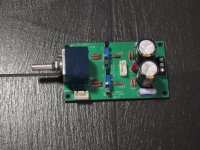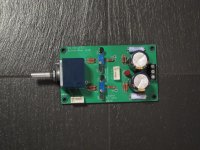Yes I know, but my question was if it will also work with +/-24V since that is what I have in my preamp already and that seems to work in the M2x.B1R2 is 12-0-12, not 24-0-24
Looks to me it should be fine. Just don't use high Idss jfets to keep the dissipation in check.
Many thanks Dennis!Looks to me it should be fine. Just don't use high Idss jfets to keep the dissipation in check.
Hello, I’ve let design some pcb for the B1 rev 2 and I have some pcb spare. If someone is intersted, please pm me.
Nice Boards!
No idea yet, but I'm sure I'll think of something 🙂
I just made my version, copy of Pico’s protoboard basically. Intend to replace my WLS, and improve my gain structure with minus 12-ish db.No idea yet, but I'm sure I'll think of something 🙂
Just succeeded in zeroing offset on one chan, very stable. Maybe solder something together during christmas 🙂
I will update along the way, and if it all works from the get go I’ll post something during Christmas. I’ll be powering it from Gaz’s regulated bipolar PSU, much alike the Whammy PSU. I don’t have the neg Salas board yet, but I think I will get a good impression of the circuits potential 🙂Interesting. It would be interesting to hear your listening impressions between WLS and the B1.
Toshibas are 10mA IDSS. So they’ll dissipate approx 120mW @ 12 volts. But I might not want to lower the PSU as far as 12 volts, it reaches 21 max. Maybe I’ll settle for 150mW, and perhaps sink the JFETs if they run hot. I have TO-92 sinks.
Edited to add: I really love the WLS. Fantastically clear and liquid. But it is way to gainy for my F2J, like mentioned before. So wanna try a buffer, capless this time. Dreaming of the IP, but this is less expensive. Had all parts except for an Adafruit @ 5 bucks.
Last edited:
How do you like the R2, assuming you use it?That sounds like a really good plan 👍 I currently use Gaz's board as well.
The Kort is very nice. Except for the ringing issues. And in my case/environment a bit of noise. Gave up the tinkering and sold it to a very happy German Hi Fi seller.Actually, I don't. The only B1 variant that I have used is the Korg. I watched thread to see what people had to say about this B1 V2. it looks like a simple easy linestage.
I had ringing issues when I used ir with a pair of LaScalas. Apparently. Other than that I haven't had any issues. I did put a piece of dampening material (a square of weatherization tape. Somewhat thick stuff) on the chassis of one. Dampening the chassis seemed to help.
Andynor, what is the "IP"?So wanna try a buffer, capless this time. Dreaming of the IP, but this is less expensive.
I guess it is the queen of buffers. TIP is even better 🙂
Turtle Iron Pumpkin
Turtle Iron Pumpkin
IP is king. Double triplet quartet buffer ultra symmetry MacDaddy with inductive attenuator. Mighty’s led-based child, conceived a few years ago.
My B1 R2 is up. Ready for listening now 🙂
My B1 R2 is up. Ready for listening now 🙂
Immediate impressions, after just a few songs, apart from very improved gainstructure, is:Interesting. It would be interesting to hear your listening impressions between WLS and the B1.
1: Even more relaxed and smooth midrange. Especially noticeable on female voices, for example Eva Cassidy. This means it is possible to play even louder without it ever getting harsh or making my ears oscillate

2: Very good bass, it is just as good as the WLS, perhaps even more natural? Hmmm
3: Highs are very relaxed, but also extended. The WLS still has the upper hand on overtones, but it is too early to tell since I only use pin sockets for JFETs and pots, whose wipers conduct the output signal. Also, the WLS does have better cabling drive capability (large output devices), so shortening them through a change in chassis layout might inprove things even further.
4: A tad more natural and relaxed. This might be due to a bunch of factors, including things I did or did not do with my WLS (matching, etc). But, given no feedback and extremeley low number of parts, there are several reasonable explanations.
Both are winners, but in my system I think a buffer is the way to go 🙂
Very cool! It sounds like it would be a fun and worthwhile little project. How does the imaging compare to the WLS?
When I assembled my 2nd WLS preamp, I matched everything with a little transistor tester to get the closer performing components in pairs. However, I didn't try to match the SMDs because I am not a masochist. Surprisingly, things were pretty close which is likely due to them being bought in bulk originally.
My first WLS board that I assembled, I didn't go through that effort. I did not hear a difference. between the two.
When I assembled my 2nd WLS preamp, I matched everything with a little transistor tester to get the closer performing components in pairs. However, I didn't try to match the SMDs because I am not a masochist. Surprisingly, things were pretty close which is likely due to them being bought in bulk originally.
My first WLS board that I assembled, I didn't go through that effort. I did not hear a difference. between the two.
- Home
- Amplifiers
- Pass Labs
- B1 Rev. 2

